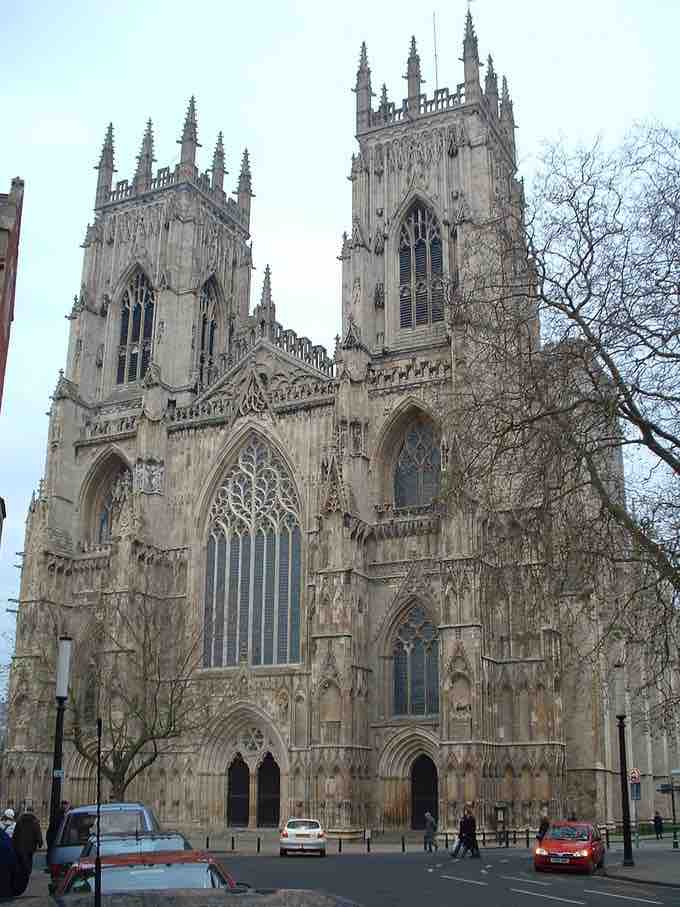Gothic architecture flourished in England from approximately 1180 to 1520. This style is defined by pointed arches, vaulted roofs, buttresses, large windows, and spires. The Gothic style was first developed in France, where the various elements had first been used together within a single building at the choir of the Basilique Saint-Denis north of Paris, built by Abbot Suger and dedicated in June 1144. The English adopted the Gothic style, however, they adapted it to their own regional preferences. While French Gothic Cathedrals were built to be increasingly tall, English Gothic Cathedrals tended to emphasize the length of the building rather than the height.
Wells Cathedral, Somerset, England
Many of the largest and finest works of English architecture, notably the medieval cathedrals of England, are largely built in the Gothic style. The earliest large-scale applications of Gothic architecture in England are at Canterbury Cathedral and Westminster Abbey. Castles, palaces, great houses, universities, parish churches, and many smaller unpretentious secular buildings, including almshouses and trade halls, were also built in this style.
Early English Gothic Period
The Early English Gothic period lasted from the late 12th century until midway through the 13th century, according to most modern scholars. By 1175, the Gothic style had been firmly established in England with the completion of the Choir at Canterbury Cathedral by William of Sens.
The most significant characteristic development of the Early English period was the pointed arch known as the lancet. Compared with the rounded Romanesque style, the pointed arch of the Early English Gothic is aesthetically more elegant and is more efficient at distributing the weight of stonework, making it possible to span higher and wider gaps using narrower columns. It also allows for much greater variation in proportions.
Using the pointed arch, walls could become less massive and window openings could be larger and grouped more closely together, so architects could achieve more open, airy, and graceful buildings. At its purest, the style was simple and austere, emphasizing the height of the building, as if aspiring heavenward. In the late 12th century the Early English Gothic style superseded the Romanesque style, and during the late 13th century it developed into the Decorated Gothic style, which lasted until the mid 14th century.
Decorated Gothic Period
The Decorated period in architecture is traditionally broken into two periods: the Geometric style (1250–1290) and the Curvilinear style (1290–1350). Decorated architecture is characterized by its window tracery, which are elaborate patterns that fill the top portions of windows. The tracery style was geometric at first, and flowing in the later period during the 14th century. Vaulting also became more elaborate, with the use of increasing numbers of ribs, initially for structural and later for aesthetic reasons.
Examples of the Decorated style can be found in many British churches and cathedrals. Principal examples are the east ends of Lincoln Cathedral and of Carlisle Cathedral and the west fronts of York Minster and of Lichfield Cathedral.

York Minster Cathedral
The west front of York Minster Cathedral is a fine example of Decorated architecture, in particular the elaborate tracery on the main window. This period saw detailed carving reach its peak, with elaborately carved windows and capitals, often with floral patterns.
Perpendicular Gothic Period
The Perpendicular Gothic period is the third historical division of English Gothic architecture, and is characterized by an emphasis on vertical lines. The Perpendicular style began under the royal architects William Ramsey and John Sponlee, and lasted into the mid 16th century.
The Perpendicular style grew out of the shadow of the Black Death, a disease that killed approximately half of England's population in 18 months between June 1348 and December 1349 and returned in 1361–62 to kill another fifth of the population. This epidemic dramatically impacted every aspect of society, including arts and culture, and designers moved away from the flamboyance and jubilation present in the Decorated style. Architects were also responding to labor shortages resulting from the plague, and therefore relied on less elaborate designs.
Perpendicular linearity is particularly obvious in the design of windows, which became immense, allowing greater scope for stained glass craftsmen. Some of the finest features of this period are the magnificent timber roofs: hammerbeam roofs, such as those of Westminster Hall (1395), Christ Church Hall, Oxford, and Crosby Hall, appeared for the first time. Gothic architecture continued to flourish in England for 100 years after the precepts of Renaissance architecture were formalized in Florence in the early 15th century.
Gloucester Cathedral
The Gloucester Cathedral exemplifies the Perpendicular Gothic Period. The interior conveys an impression of a "cage" of stone and glass, typical of the period. The walls and windows are sharper and less flamboyant than those of the earlier style.